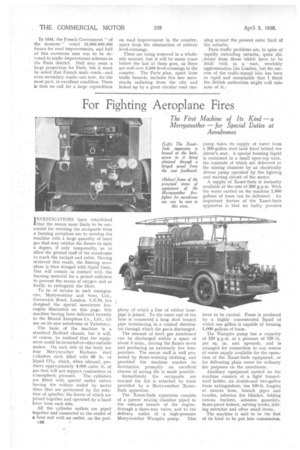For Fighting Aeroplane Fires
Page 70

If you've noticed an error in this article please click here to report it so we can fix it.
INVESTIGATIONS have established that the means most likely to be successful for rescuing the occupants from a burning aeroplane are to envelop the machine with a large quantity of inert gas that may subdue the flames to such a degree, if only temporarily, as to allow the ground staff of the aerodrome to reach the cockpit and cabin. Having achieved this result, the flaming aeroplane is then deluged with liquid foam, that will remain in contact with the burning material for a period sufficient to prevent the access of oxygen and so finally to extinguish the blaze.
To be of service in such emergencies, Merryweather and Sons, Ltd., Greenwich Road, London, S.E.10, has designed the special aerodrome fireengine illustrated on this page, this machine having been delivered recently to the Bristol Aeroplane Co., Ltd., for use on its new aerodrome at Yatesbury. The basis of the machine is a standard Bedford chassis, but it will, of course, be realized that the equipment could be mounted on other suitable makes. On each side of the body are four Merryweather Karbono steel cylinders each filled with 60 lb. of liquid C0.r, which, when released, produces approximately 4,000 cubic ft. of gas that will not support combustion at atmospheric pressure. The cylinders are fitted with special outlet valves having the orifices sealed by metal discs that are perforated by the rotation of spindles, the levers of which are joined together and operated by a hand lever from each side.
All the cylinder outlets are piped together and connected to the centre of a hose reel with an outlet, on the peri
c48
phery of which a line of rubber hosepipe is joined. To the outer end of the hose is connected a long steel branch pipe terminating in a conical distributor through which the gas is discharged.
The amount of inert gas mentioned can be discharged within a space of about 3 mins., driving the flames down and producing an extremely low temperature. The rescue staff is well protected by flame-resisting clothing, and provided the machine reaches its destination promptly an excellent chance of saving life is made possible.
Immediately the occupants are rescued the fire is attacked by foam provided by a Merryweather XaustSuds apparatus.
The Xaust-Suds apparatus consists of a patent mixing chamber piped to the exhaust branch of the engine, through a three-way valve, and to the delivery outlet of a high-pressure Merryweather Warspite pump. This
have to be carried. Foam is produced by a highly concentrated liquid of which one gallon is capable of forming 1,000 gallons of foam.
The Warspite pump has a capacity of 120 g.p.m. at a pressure of 120 lb. per sq. in. and upwards, and is arranged for connection to any source of water supply available for the operation of the Xaust-Suds equipment, or for delivering plain water for ordinary fire purposes on the aerodrome. , Auxiliary equipment carried on the machine consists of a light trussedsteel ladder, six double-seal two-gallon foam extinguishers, ten 100-ft. lengths of canvas hose, branch pipes and nozzles, asbestos fire blanket, folding canvas buckets, asbestos gauntlets, flame-proof helmet, salving hooks, folding 'stretcher and other small items, The machine is said to be the first of its kind to be put into commission.












































































































